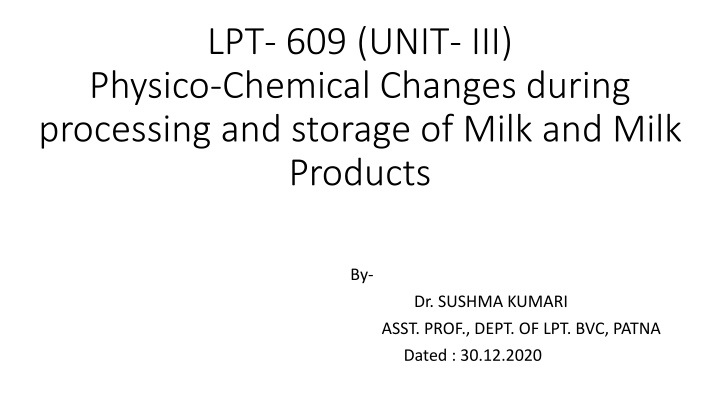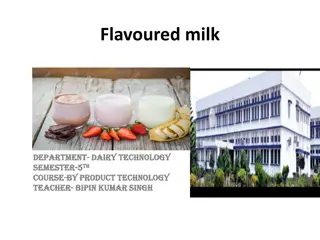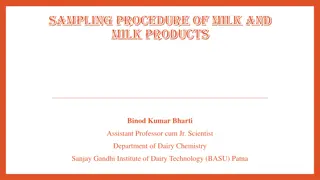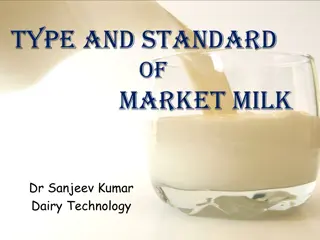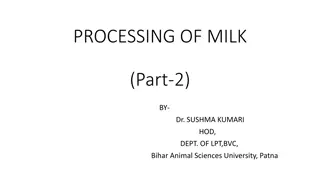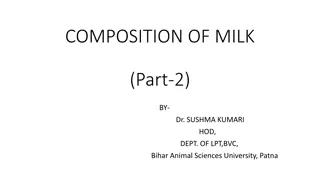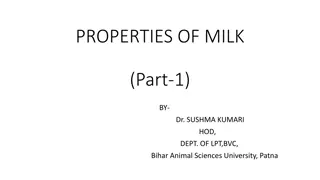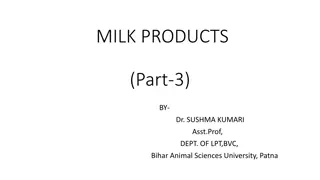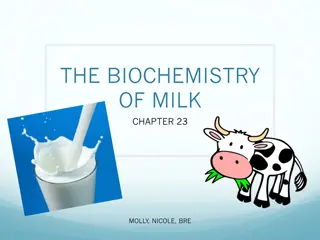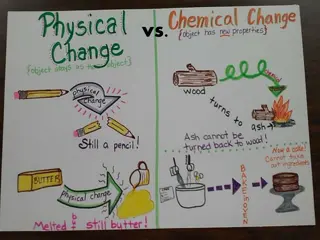Physico-Chemical Changes in Milk and Milk Products During Processing and Storage
Physico-chemical changes occur in milk and milk products during processing and storage, including alterations such as salt precipitation, protein denaturation, and flavor changes. Heat treatments like autoclaving and freezing impact the composition, properties, and flavor of milk. Understanding these changes is essential in the dairy industry to ensure product quality.
Download Presentation

Please find below an Image/Link to download the presentation.
The content on the website is provided AS IS for your information and personal use only. It may not be sold, licensed, or shared on other websites without obtaining consent from the author.If you encounter any issues during the download, it is possible that the publisher has removed the file from their server.
You are allowed to download the files provided on this website for personal or commercial use, subject to the condition that they are used lawfully. All files are the property of their respective owners.
The content on the website is provided AS IS for your information and personal use only. It may not be sold, licensed, or shared on other websites without obtaining consent from the author.
E N D
Presentation Transcript
LPT- 609 (UNIT- III) Physico-Chemical Changes during processing and storage of Milk and Milk Products By- Dr. SUSHMA KUMARI ASST. PROF., DEPT. OF LPT. BVC, PATNA Dated : 30.12.2020
ALTERATIONS OCCURRING IN MILK AND MILK PRODUCTS DURING PROCUREMENT,PROCESSING & STORAGE In the dairy industry, milk is commonly given heat treatment for a wide variety of purposes. Depending on the heating temperature, this procedure may cause several changes in milk, such as salt precipitation, due to the formation of insoluble complexes, protein denaturation and interactions among milk components. Heating milk at near boiling point causes a film or skin to form on the surface. This skin is mainly due to calcium caseinate but the other constituents in milk are also present in it.
Autoclaving milk, wherein temperature of around 121o C is achieved, causes browning. The brown colour is due to the heat effecting an interaction between the casein (or amino acids) and the sugar. The process employed to heat milk also affects the changes in physico-chemical properties of milk. Research has shown that changes in certain physical and chemical properties of ultra-heated milk (95o C to 145o C) were much more severe when the milk was heated by indirect as compared to direct (steam injection) process. Increased browning and a greater amount of whey protein denaturation were particularly noticeable in ultra heated milk.
Apart from the above mentioned alterations, certain flavor changes also occur in milk, depending on the temperature and duration of heating. Heating milk to high temperatures causes a cooked flavor to appear. In the holding method of pasteurization (62o C for 30 minutes) or the high-temperature short-time (HTST), 71o C for 15 minutes methods - very little cooked flavor is noticed, but at higher temperatures or longer periods of heating, cooked flavor becomes more apparent. The flavor appears at 70o C on momentary heating. This cooked flavor has been shown to be due to the production of sulfhydryls (compounds with a - SH group, found in many plant and animal enzymes) by high temperatures. Sulfhydryl compounds are readily oxidized and delay the oxidation of fat in milk or cream heated to high temperatures. Oxidized flavors in milk do not usually appear until the sulfhydryls are oxidized and the cooked flavor has disappeared.
Freezing the milk also alters its composition and properties to a great extent. As the milk freezes, it becomes very uneven in the composition of the frozen and other solids, while the liquid portion becomes concentrated with the milk solids, so much so that milk never freezes solid entirely. Freezing alters the physical condition of milk to the extent that it never returns to its original state. It causes the fat globules to lose their complete emulsion structure, to clump and become distorted and irregular in shape and size. The casein is also affected by freezing. It is partly broken from its existence in milk as calcium caseinate and gets precipitated as flakes. This condition, together with some free fat particles, gives the thawed-out milk an unnatural appearance. The flavor is also affected, being rather watery to the taste.
The caseinate micelles of milk, which are quite stable to heat, may be destabilized by freezing. On frozen storage of milk, the stability of the caseinate progressively decreases and may lead to complete coagulation. Casein is an important example of protein, which can be boiled without apparent change in stability. The exceptional stability of casein makes it possible to boil, sterilize and concentrate milk, without coagulation
Low temperatures and aging induce clumping of the fat globules of milk, which increases the viscosity. Mechanical agitation of whole milk decreases the viscosity, because the fat globule clumps are partially broken up, while in the case of skim milk, it has no effect due to the presence of small amount of fats. Homogenized milk will not be affected, as the fat globules are already broken up. Homogenization increases the viscosity of whole milk but slightly decreases that of skim milk. This process breaks up the fat globule into much smaller ones and thereby provides ______________________________________________________________ a larger surface area.
A film of protein is adsorbed on the surface of the globules and this surface being much larger than in the non-homogenized milk, a much greater adsorption takes place, which causes a higher viscosity. Skim milk, some of the protein particles may be broken and therefore, the viscosity will be reduced. Pasteurization temperatures slightly lowers the viscosity through breaking the clumps of fat globules, but when subjected to high heat, or high pressure, the viscosity is increased due to the denaturation of proteins.
